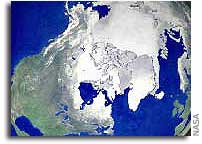NASA Takes a Rare Look at Warming Arctic

HAMPTON, Va. – A NASA field campaign to study man-made and natural influences on the Arctic atmosphere delivered a collection of rare data that is illuminating the impact of industrial pollution from Europe and Asia, and smoke and soot from agricultural and forest fires.
NASA’s first in-depth airborne campaign to sample the Arctic atmosphere in years, the Atmospheric Composition of the Troposphere from Aircraft and Satellites (ARCTAS) mission took place in the spring and summer of 2008. It was the first in-depth airborne campaign to sample the Arctic atmosphere in years beginning in cooperation with NOAA, the Department of Energy, and international agencies as part of the International Polar Year.
Scientists from NASA and a number of universities will be presenting their ARCTAS research results from the campaign during the American Geophysical Union’s fall meeting in San Francisco from Dec. 14-18.
Aircraft observations revealed a stronger influence of Asian pollution than previously thought and saw smoke plumes travel to the Arctic from great distances. While ground-based instruments and satellites make routine measurements, these up-close airborne measurements provide a more finely resolved look at the changing chemistry of the Arctic, the most rapidly warming region on Earth.
“For scientists interested in studying the role of changing atmospheric composition on climate, the ARCTAS data will represent the best and often only detailed information available for this poorly characterized region,” said Jim Crawford, a research scientist at NASA’s Langley Research Center and the ARCTAS program manager during the campaign.
Tiny, airborne particulates called aerosols, produced from sources including industrial exhaust and fires, can be carried to the Arctic in massive plumes. Smoke and pollution can act as warming agents, by absorbing incoming solar radiation and reflected infrared radiation from Earth, or sometimes as cooling agents, by reflecting sunlight before it reaches the surface depending on the composition of the aerosol.
These aerosols can also be deposited on the Arctic’s snowy and icy surfaces and darken the natural albedo (surface reflectivity of the sun’s radiatio at the polar ice cap, causing radiative heating right at the surface.
Daniel Jacob, a Harvard University atmospheric scientist and ARCTAS mission scientist and co-principal investigator, said early ARCTAS results have been surprising and become an important tool.
“We’re getting to the point where results from ARCTAS are getting into climate models. We’re able to test different models of snow albedoes, and we’ve been able to introduce some corrections,” Jacob said. “The Asian pollution we saw turned out to be a much larger influence on Arctic haze than what had been traditionally ascribed.”
Temperatures in the Arctic are increasing and the extent of summer sea ice was recently measured at 40 percent below its 20-year average. As scientists continue to study the make-up of the Arctic atmosphere to unlock the chief causes of the warming trend, the most accurate data possible is a necessity.
The airborne ARCTAS measurements were made from three NASA aircraft









